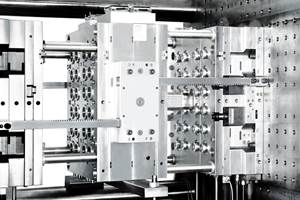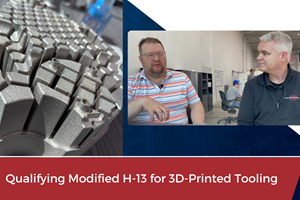Laser Welding Improves Surface Finish and Yields Less Rework
With laser welding, the tool steel doesn't harden, soften or crack the area. It keeps distortion and weld sink down.
Five Star Tool Welding Corp. (Butler, WI) has specialized in welding/mold repair for more than two decades—particularly in TIG and micro TIG welding. When laser welding became the industry buzzword approximately 5 years ago, Five Star President Joe Canfield decided to give it a trial run, and was so impressed with the results of laser welding equipment manufactured by O.R. Lasertechnology Inc. (Elk Grove Village, IL) that he currently has three machines in his shop—two HTS Mobile 160 laser welding systems and a LRS 120 laser welding system.
Nearly 90 percent of this Five Star’s business is plastic injection molds for both tool shops and molders—with a small portion attributed to die cast. The company used to only perform TIG and micro TIG welding before bringing laser welding machines into the shop. “The biggest challenge we face when we TIG weld is that there is a lot of heat input into the parts,” he notes. “Most pieces had to be preheated because the tool steels were in the hardened condition and we didn’t want to crack them.”
Canfield did his homework, researching a variety of equipment before choosing O.R. Lasertechnology units. “We decided to give the machine a try for three weeks,” he states. One of O.R.’s employees stayed here for a day and showed us how everything worked. He even did a couple of jobs for us. We were very pleased with the results, and purchased another unit three months later. We just purchased our third unit six months ago.”
Canfield points out that training was relatively simple after the O.R. representative spent the day with them. “You don’t necessarily have to be a welder to operate a laser welder,” he says. “It is mostly about hand/eye coordination. After someone is trained, we let them play with the machine for a little while. It is a self-learning skill that comes with practice.”
Laser Welding Benefits
“With laser welding, the tool steel doesn’t have to be preheated because the heat input is so minute it doesn’t disrupt any of the surrounding area, that is, it doesn’t harden, soften or crack the area,” Canfield explains. “In that respect it keeps distortion and weld sink down.
“It makes the molds look a lot better,” Canfield continues, “because minimal amount of weld and shrink is actually added to the areas (other welding methods cause shrink). There also is no heat affected zone because the laser doesn’t affect the surrounding area. Plus, there is no preheating and less rework. When the customer gets a laser job back, they save a ton of money because it was lasered welded versus TIG or micro TIG welded where they would have to spend extra time taking weld off. In some cases this time can be cut in half.”
Adding laser welding to Five Star’s capabilities has definitely expanded Canfield’s business. “We have secured more customers with our laser welding services,” Canfield emphasizes. “As a result of adding O.R. machines, laser welding comprises approximately 70 percent of our business.”
Related Content
What You Should Consider When Purchasing Modified P20 Steel
When buying P20 steels that have been modified, moldmakers must be aware of the variations and key issues that affect delivery, cost and lead times.
Read MoreHow to Lower Cycle Times With the Right Tool Steel
Combining excellent mechanical properties, high wear resistance and high thermal conductivity in a specialty tool steel yields cycle time reduction.
Read MoreVIDEO: Qualifying Modified H-13 for 3D-Printed Tooling
Next Chapter Manufacturing and International Mold Steel discuss their partnership to qualify a modified H-13 for tooling applications.
Read MoreModified Composition Enhances Stainless Steel Capabilities
Edro introduces Böhler’s M333 Isoplast stainless steel which has been manufactured via a new melting technology for best-in-class polishability, conductivity, toughness and corrosion resistance.
Read MoreRead Next
Reasons to Use Fiber Lasers for Mold Cleaning
Fiber lasers offer a simplicity, speed, control and portability, minimizing mold cleaning risks.
Read MoreAre You a Moldmaker Considering 3D Printing? Consider the 3D Printing Workshop at NPE2024
Presentations will cover 3D printing for mold tooling, material innovation, product development, bridge production and full-scale, high-volume additive manufacturing.
Read MoreHow to Use Continuing Education to Remain Competitive in Moldmaking
Continued training helps moldmakers make tooling decisions and properly use the latest cutting tool to efficiently machine high-quality molds.
Read More








.png;maxWidth=300;quality=90)

.jpg;maxWidth=300;quality=90)

_300x250 4.png;maxWidth=300;quality=90)












